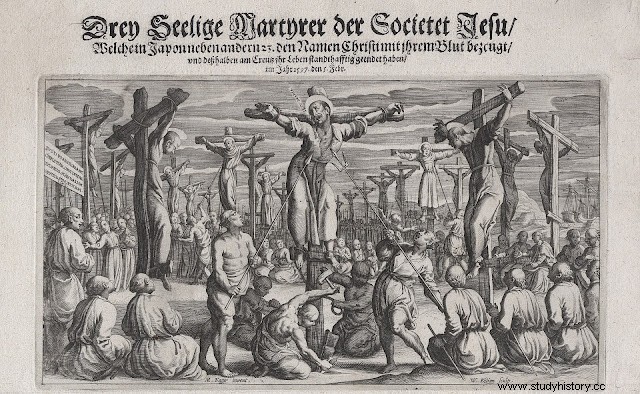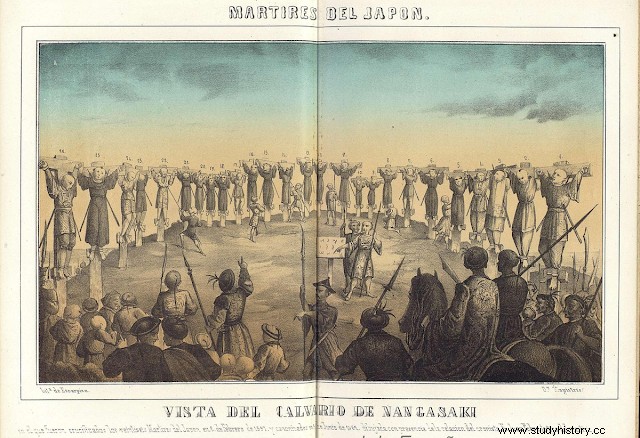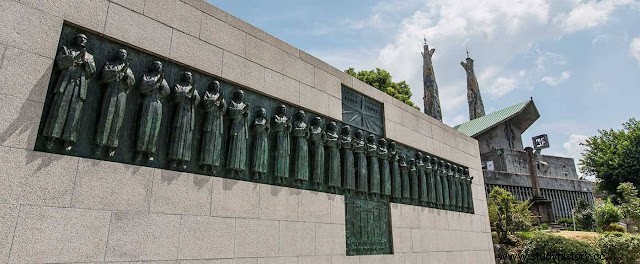On February 5, 1597, 26 Christians (Jesuits, Franciscans and Japanese converts) were crucified on the hill of Nagasaki (Japan) by an imperial order based on to a lie, according to which these Catholic priests would actually be the advance guard of a conquering Spanish army.
 Crucifixion of the martyrs
Crucifixion of the martyrsOn August 15, 1549, the Jesuit priests Francisco Javier, Cosme de Torres and Juan Fernández came to Kagoshima from Spain with the hopes of bringing Catholicism to Japan. On September 29 of that year, Javier visited Shimazu Takahisa, the daimyō of Kagoshima, asking permission to build the first Catholic mission in Japan. The daimyō consented in the hope of being able to have a commercial relationship with Europe.
This tolerant attitude towards the missionaries of the Society of Jesus ended with the assassination of Oda Nobunaga in the Honno-ji incident and subsequent rise to power of one of his main vassals, Toyotomi Hideyoshi. Hideyoshi, with more conservative attitudes towards foreign influences, subverted the policy of his predecessor and promulgated in 1587 the first edict prohibiting Christianity in Japan and expelling the Jesuit missionaries.
This edict was the first step in a long repression that had its peak, after the San Felipe incident, with the death sentence of 26 Christians:4 European Franciscan missionaries, a Franciscan from New Spain (San Felipe de Jesús), an Indian (San Gonzalo García), 3 Japanese Jesuits and 17 Japanese laymen, including 3 minors, who left Kyoto escorted by soldiers and were executed on Nishizaka Hill, outside Nagasaki. Individuals were raised on crosses and speared before the crowd.
 Illustration of the crucifixion
Illustration of the crucifixionAccording to the Jesuit Diego R. Yuki, the Portuguese, Spanish and Christians Japanese who contemplated the scene, broke the cordon of the soldiers, ran towards the crosses and soaked pieces of cloth in blood and took pieces of the habits and kimonos of the executed. The soldiers beat them out of there. When order was restored, Terazawa Hanzaburo (brother of the Governor of Nagasaki and who crucified the 26 martyrs) posted sentinels with severe orders so that no one approached. Afterwards, the hill began to fill with prayers from various people. The bodies had to be covered.
In the following days Terazawa had the place fenced off with bamboo poles and reinforced the guard. However, by day the Christians simulated business that forced them to pass by the path of the hill stopping on it, until the sentinels forced them to continue. At night small boats would stealthily approach the cliff. The people of Nagasaki lived on the slopes of Nishizaka Hill. The following year in 1598, a legate from the Philippines had collected, with prior authorization from Toyotomi Hideyoshi, the last remains of the victims and their crosses; Only the holes remained, which little by little were becoming blind. In subsequent years the persecution continued sporadically, exploding again between 1613 and 1637, during which time Catholicism was officially banned. The Catholic Church in Japan remained clergyless and theological teaching disintegrated until the arrival of missionaries from the West in the 19th century.
Two and a half centuries after the execution, when Christian missionaries returned to Japan, they found a community of Japanese Christians who had survived by hiding. Just as there were quite a few other martyrs (especially in Nagasaki), the first were especially revered, the most celebrated of whom was Saint Paul Miki of the Society of Jesus. Of the 26 martyrs of Japan, 23 of them were beatified on September 15, 1627, and the 3 Jesuits in 1629. In the canonization there were also differences, but all 26 were canonized on June 10, 1862 by Pope Pius IX.
 Monument to the 26 martyrs of Nagasaki
Monument to the 26 martyrs of NagasakiThis is the list and profile of each of the 26 Christians crucified:
Saint Francis, the Kyoto carpenter Stubborn, faithful, that he followed the others until he managed to be added to them. "Adaucto" is called by some of the chronicles, recalling a similar event in the history of the early church.
Saint Cosme Takeya The swordsmith, a native of Owari, baptized by the Jesuits and catechist of the Franciscans with whom he worked in Osaka.
Saint Peter Sukejiro The young man from Kyoto, sent by Father Organtino to help the Martyrs during his pilgrimage. His selfless service earned him being added to the group.
Saint Michael Kozaki Forty-six years old, bow and arrow maker, a native of Ise province. He was already a Christian when the friars arrived and put his skills as a carpenter at their service, helping them build the churches of Kyoto and Osaka. And he gave them something that was worth even more:his son, Thomas, his.
San Diego Kisai The brother Coadjutor devoted to the Passion of the Lord, with his sixty-four years, his hard-working life and his serene soul. He was a native of Okayama, and was in charge of taking care of the guests in the house of the Jesuits in Osaka.
Saint Paul Miki From the kingdom of Tsunokuni, son of the brave captain Handayu Miki. Educated as a child at the Seminary of Azuchi and Takatsuki, he had followed in his life as a Jesuit all the vicissitudes of the Japanese Church. He passionately loved his apostolic life. He was already very close to his priesthood. He was the best preacher in Japan; he only fell silent when the spears broke the heart of the thirty-three-year-old.
Saint Pablo Ibaraki From Owari. He was a samurai in his youth. Baptized by the Jesuits, he knew the fight of temptation against faith and also the peace of the soul, which he achieved in his last years in the shadow of the convent of Our Lady of the Angels, in Kyoto. He lived poorly with his family on the profits from making rice wine, and helped others poorer than himself. And he also preached Christ.
Saint John of Gotoo With his nineteen immaculate and joyful years, with his short life well filled in the service of God. A native of the Gotoo Islands, the son of Christian parents, he was educated by the Jesuits in Nagasaki and then at the college they set up in Shiki (Amakusa) for their catechists, musicians, and painters. From there he went to Osaka where he worked with Father Morejón until God offered him the crown.
Saint Luis Ibaraki The youngest of the Martyrs, twelve years old, from Owari, nephew of the Martyrs Pablo Ibaraki and León Karasumaro. The boy who laughed and sang when they cut off his ear and on the road and on top of the cross; who rejected the insinuating invitations to apostasy with manly energy.
«Here goes Luisillo, with so much courage and effort that he admires everyone», San Francisco Blanco had written on the eve of his death.
Saint Anthony Deynan From Nagasaki, a candid heart of thirteen years old, the son of a Chinese father and a Japanese mother, educated first at the Jesuit college in Nagasaki and then at the Franciscan convent in Kyoto.
He overcomes the greatest temptation at the foot of the cross the tears of his mother. He then dies singing.
Saint Peter the Baptist Ambassador of Spain, commissioner of the Franciscans, father of the poor lepers, captain of Martyrs. From San Esteban del Valle (Ávila) to the Nishizaka hill, his forty-eight-year-old life has too many pages of work and holiness to be able to summarize it here.
San Martín de la Ascensión From Guipúzcoa, thirty years old. They say that his purity was very great, maybe that's why he sang so much. He went on foot to Seville when he received the order to leave for the Philippines, and in the old convent in Plaza de San Francisco he shared the night hours with a companion to fill them with prayer.
His apostolate in Japan, in Osaka, his death was brief, splendid.
Saint Felipe de Jesús, or de las Casas Twenty-four years old, from Mexico. Good silver carved by God. His young life was a crossroads, a clash of wills. Christ and Philip fight arm in arm.
Conquered in that fight, Philip feels the urge to rescue lost time, he is the first to die.
Saint Gonzalo García Forty years old, born in the distant 'dom' Bazain, (Vasei) of a Portuguese father and an Indian mother. Jesuit catechist, merchant in Macao, Franciscan layman. The right arm of Saint Peter the Baptist. He stutters when speaking Portuguese and confronts the lord of Japan in fluent Japanese. He is the patron saint of the diocese of Bombay, India.
Saint Francis White The Galician from Monterrey (Orense), companion of San Martín de la Ascensión and similar to him even in walking to Seville. A peaceful, silent man of clear intelligence.
San Francisco de San Miguel Fifty-three years old, from La Parrilla (Valladolid). I would like to say many things about him, since he was so quiet in his life. "Seeing his good spirit and his bodily strength and his little malice, they gave him the habit of a lay friar." What things do the old chronicles say! He also said them:That typical phrase of his:«Tomorrow they will ring to eat», when they wanted to make him give up his fasts; that liking to inhale "Japanese winds", when he was in Manila, Philippines. And then his dark night on the mission, when he imagines that he is useless there and wishes to return to the Philippines. His death, like his life, silent.
Saint Matthias We do not know his age, nor his hometown, nor the date of his baptism. We only know the name and the trait with which he achieved martyrdom. The soldiers were looking for another Matías; he offered himself in his place, the soldiers accepted him; God too.
Saint Leo Karasumaru From Owari, younger brother of Saint Paul Ibaraki. He was a Buddhist monk in his youth. Won to Christ by a Japanese Jesuit, his life was always a model of fervor. When the Franciscans arrived, he was his main supporter. In the construction of the churches, the acquisition of the land or the management of the hospitals, they could always count on León. Zealous catechist, man of prayer, he figures in the history of martyrdom as the head of the group of secular martyrs.
Saint Ventura His young life bears the stamp of the mysterious ways of God. Baptized very young, he loses his mother after a few years; a pagan stepmother comes and Ventura is entrusted to a monastery of bonzes. One day he discovers that he is baptized, he searches and in the Franciscan convent of Kyoto, his hometown, he finds peace of soul. Praying for his father's perseverance and his stepmother's conversion, he walks to the cross.
Saint Thomas Kozaki Beneath somewhat rough appearances, his fourteen-year-old's heart is as beautiful as the pearls of Ise, his homeland. Already a Christian, he entered the Franciscan circle with his father. With the friars he stays to live in the convent of Osaka. Straight character, determined, he delivers him with a shadowless sincerity. The farewell letter that he writes to his mother from Mihara castle is one of the jewels that enamel the route of the twenty-six Martyrs.
San Joaquín Sakakibara Forty years old, from Osaka. Baptized by a catechist when he was seriously ill, he later shows his gratitude for the gift of baptism by helping to build the Franciscan convent in Osaka, where he later works as a cook. His angry character softens, he becomes humble, helpful. And God takes him out of his kitchen to take him to the altars.
Saint Francis, the apostle doctor Kyoto native, forty-eight years old. He still a pagan he wore for four years a rosary that had belonged to Francisco Otomo, the daimyō of Bungo. Touched by grace, he arrives at the Franciscan convent. Once baptized and after converting his wife, he spends his life next to the convent healing the poor for free, bringing light to souls.
Santo Tomás Dangui The pharmacist with a terrible character, changed by grace into a kind catechist. A former Kyoto Christian, he moved his little shop next door to Our Lady of the Angels Convent. He lived from the sale of his medicines and taught others the way to heaven.
San Juan Kinuya Twenty-eight years old, from Kyoto. He manufactured and sold silk fabrics. Recently baptized by the Franciscan missionaries, he went to live near them. Many prayers and much love were intertwined in his soft, brightly colored fabrics. And God was pleased with that life of prayer and work.
Saint Gabriel Ise native. Another young life, nineteen years old, happily immolated. He leaves the service of a high official of Kyoto for that of the house of God. Converted by Fray Gonzalo, he knew how to walk quickly, avoiding the obstacles that opposed him. He was a catechist.
Saint Paul Suzuki Forty-nine years old, from Owari. To the very edge of the hill, so that his burning, apostolic word can fly freely. Thirteen years had passed since he received baptism. The fiery character of his, attested by scars on his body, was transformed into zeal, and he was one of the best catechists of the Franciscans, the one in charge of the hospital of Saint Joseph, in Kyoto.
